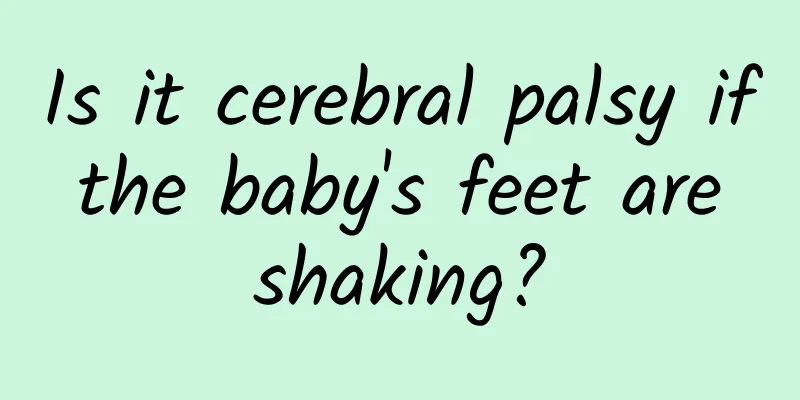Is it cerebral palsy if the baby's feet are shaking?

|
Sometimes babies have shaking legs, which is usually caused by spasms. At this time, you should be alert to the disease and go to the hospital for examination in time to see if the child has brain damage. If there is brain damage, it may cause cerebral palsy in the child and cause such symptoms. If the newborn shows some symptoms of cerebral palsy, parents should observe it in time and go to the hospital for diagnosis in time. 1. Early symptoms (1) Newborns or three-month-old infants are easily startled, cry incessantly, refuse to drink milk, and have difficulty sleeping. (2) Difficulties in early feeding, chewing, drinking, and swallowing, as well as drooling and breathing disorders. (3) Low sensory threshold, manifested as being easily startled by noise or changes in body position, and having an increased hugging reflex accompanied by crying. (4) In normal infants shortly after birth, due to the stepping reflex, when standing upright, the two feet can be seen stepping alternately. Although it may disappear once at 3 months of age, if the child still has no signs of standing or taking steps at 3 months of age, cerebral palsy should be suspected. (5) Babies over 100 days old are still unable to lift their heads, and their heads still sway when they straighten their backs at 4 to 5 months. (6) Fist clenching: Generally, infants can clench their fists but not open them within 3 months after birth. If the thumb is still adducted and the hand cannot be opened at 4 months, cerebral palsy should be suspected. (7) Normal babies should be able to reach out and grab objects when they see them between 3 and 5 months old. If they still cannot do so after 5 months, they may be suspected of having cerebral palsy. (8) Generally, babies will smile 4 to 6 weeks after birth and recognize people later. Children with spastic cerebral palsy have apathetic expressions, while children with athetoid cerebral palsy often look sad. (9) The muscles are loose and unable to turn over, and the movements are slow. When you touch the inner thigh of the child, or let the child's feet rest on the bed or jump up and down, the lower limbs will extend and cross. (10) Stiffness, especially when getting dressed, the upper limbs are difficult to put into the cuffs; when changing diapers or washing, the thighs are difficult to bend outward; when wiping the palms and taking a bath, the limbs become stiff. Babies don't like baths. (11) Premature development: Children with cerebral palsy may roll over prematurely, but it is a sudden reflexive rolling over, with the whole body rolling over like a log, rather than a conscious segmental rolling over. Infants with spastic diplegia may have stiff legs before they can sit up and stand on pointe like a ballerina.Main symptoms (1) Movement disorders: Poor motor self-control ability. In severe cases, the patient cannot grasp objects with his hands or walk with his feet. Some patients cannot even turn over, sit up, stand, or chew and swallow normally. (2) Postural disorders: Various abnormal postures, poor posture stability, the head cannot be kept straight at 3 months, and is accustomed to leaning to one side, or swaying left and right, front and back. The child does not like to take a bath and has difficulty opening his fist when washing his hands. (3) Intellectual Disability: About 1/4 of the children have normal intelligence, about 1/2 have mild or moderate intellectual disability, and about 1/4 have severe intellectual disability. (4) Language barriers: difficulty in language expression, unclear pronunciation or stuttering. (5) The most common visual and auditory disorders are esotropia and difficulty in distinguishing the rhythm of sounds. (6) Growth and development disorders and short stature. (7) Developmental disorders cause teeth to be loose and easy to break. Orofacial dysfunction, with spasms or sometimes uncoordinated contractions of the facial and tongue muscles, difficulty chewing and swallowing, difficulty closing the mouth, and drooling. (8) Emotional and behavioral disorders: Stubbornness, willfulness, irritability, and withdrawal, with mood swings and sometimes compulsive, self-harming, and aggressive behaviors. (9) 39% to 50% of children with cerebral palsy develop epilepsy due to fixed lesions in the brain, especially those with severe intellectual disability. |
<<: Will my baby have cerebral palsy if he has high jaundice?
>>: Is it cerebral palsy if the baby keeps sticking out his tongue?
Recommend
Can I have a baby at 34 weeks of pregnancy?
40 weeks of pregnancy is a relatively standard ti...
Dry skin and itching are often related to three factors
In autumn and winter, many people's skin will...
Introduction to the hypothalamus and pituitary
We all know that the hypothalamus and pituitary g...
What are the symptoms of poor lung function?
The lungs are important organs for human breathin...
Patients with kidney deficiency type hair loss need to maintain a good attitude
There are many types of hair loss, and kidney def...
There is a herniated cervical vertebra
If you find that you have a protrusion in your ce...
Is drinking red wine good for high blood pressure?
There are many differences between red wine and w...
What to do if you have trouble breathing
Breathing is mainly the human body's respirat...
What to do if the glans nerve is too sensitive
It is said that the male penis is the most sensit...
Severe pain in neck and shoulders
Nowadays, people like to play with their mobile p...
The demons of newlyweds may be very close to you
Cancer was diagnosed three days after marriage: A...
What is the reason for hair loss on the head?
The most common cause of hair loss on the head is...
What is cervicitis? What physical signs should we pay attention to?
Gynecological diseases have become one of the kil...
What are the side effects of tattoo anesthetics?
Tattoos are a way for many young people to expres...
Where should I apply moxibustion for Qi deficiency? People who are most suitable for moxibustion
People with yang deficiency and qi deficiency are...









